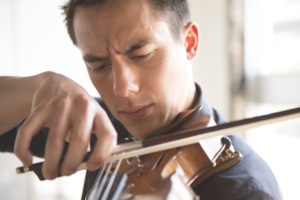The Theatre at the Bard’s Town Restaurant was the venue for this performance by Louisville’s Period Instrument Ensemble, Bourbon Baroque. The Theatre, located on the upper level, is a great space for early music concerts.
The program began with the Tombeau de Monsieur de Meliton for two Violas da Gamba and Continuo by French Baroque composer Marin Marais. Mr. Marais was a student of Lully and a master of the Viola da Gamba. In fact, he was the leading French composer of music for that instrument. It was he who “founded and firmly established the empire of the viol.” This piece was beautifully played by the ensemble. The slow and sustained phrases were glorious. The entire piece was a joy to the “listening soul.” The same can be said for the next piece, the Allemande from the Suite in D Minor for three Violas da Gamba and Continuo by Antoine Forqueray. The group was very connected to the music and to each other and the rendering of these two pieces was mesmerizing.
The Passacaglia (Passacaille in French) is a piece composed for organ or harpsichord whose foundation is the basso ostinato (ground bass). This form is majestic and often sorrowful and employs a slow tempo in a triple meter. (One of the best known examples of the passacaglia in Western classical music is the Passacaglia and Fugue in C Minor by J. S. Bach.) However, the French clavecinists, especially Louis Couperin, were noted for their use of the passacaille form. Johan Austin Clark’s performance of the Passacaille in G by Louis Couperin transported the audience right to the grand court of Louis XIV and all its majesty. Bravo to John Austin for an interpretation that was truly magnifique!
Violinists Nicola Fortin and Margaret Little next delighted the audience with the Sonata in C Minor by Telemann. The sighing phrases in the Affettuoso movement were beautiful, and the excitement of the Vivace and Allegro movements was brilliant!
The concert concluded with the featured work of the evening, the Brandenburg Concerto No. 6 in B Flat, BWV 1051, by Johann Sebastian Bach. Bach wrote a set of six instrumental works that he presented to Christian Lugwig, Margrave of Brandenburg; hence the name, Brandenburg Concertos. These concertos are among the finest and most popular musical compositions of the Baroque era. The Concerto No. 6 is scored for two Violas da Braccio, two Violas da Gamba, Cello, Violone, and Harpsichord. Once again, this ensemble played flawlessly. The musical interweaving of the viola parts, the support of the lower strings and harpsichord, combined with the vast musical knowledge of the players created a stellar performance.
Just another wonderful evening with Louisville’s Period Instrument Ensemble, Bourbon Baroque!
Bourbon Baroque
http://www.bourbonbaroque.com/




